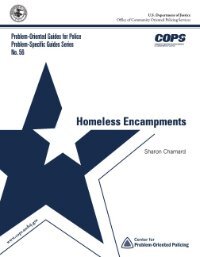This guide addresses homeless encampments, also known as transient camps. It begins by describing the problem and reviewing factors that contribute to it. It then identifies a series of questions to help you analyze your local problem. Finally, it reviews responses to the problem and what is known about them from evaluative research and police practice. Homeless encampments are only one aspect of the larger set of problems related to homelessness, street life, and public disorder.
This guide addresses effective responses to the problem of graffiti—the wide range of markings, etchings, and paintings that deface public or private property. In recent decades, graffiti has become an extensive problem, spreading from the largest cities to other locales. Despite the common association of graffiti with gangs, graffiti is widely found in jurisdictions of all sizes, and graffiti offenders are by no means limited to gangs.
This guide deals with the problem of false burglar alarms. It begins by reviewing factors that increase the risks of false burglar alarms. It then identifies a series of questions that might help you analyze your local problem. Finally, it reviews responses to the problem and what is known about them from evaluative research and police practice. False burglar alarms is but one aspect of the larger set of problems related to alarms and misuse of police resources. This guide is limited to addressing the particular harms created by false burglar alarms.
This guide begins by describing the problem of drug-impaired driving and reviewing factors that increase its risks and negative outcomes. It then identifies a series of questions to help you analyze your local drug-impaired driving problem. Finally, it reviews a number of responses to the problem and summarizes what is known about these responses from evaluative research and police practice. Drug-impaired driving demands police, legislative, and community attention because of the harms it may cause.
If you have an apartment complex in your community where drug dealing is occurring, you may have found that simply making arrests has not closed the drug market. What else could be done? Why is this problem occurring? What conditions facilitate the drug market's operations, and what remedies will work best? This guidebook addresses these issues. It describes the types of drug markets found in apartment complexes and provides questions to ask when analyzing those markets. It suggests ways to encourage property owners to take more responsibility for problems. Finally, it summarizes the full range of measures you can use to address drug markets in apartment complexes.
This guide begins by describing the problem of drive-by shootings and reviewing factors that increase its risks. It then identifies a series of questions to help you analyze your local drive-by shootings problem. Finally, it reviews responses to the problem and what is known about them from evaluative research and police practice. Drive-by shootings are but one aspect of the larger set of problems related to gang and gun violence. This guide is limited to addressing the particular harms drive-by shootings cause..
This guide begins by describing the problem of domestic violence and reviewing factors that increase its risks.† It then identifies a series of questions to help you analyze your local domestic violence problem. Finally, it reviews responses to the problem and what is known about these from evaluative research and police practice. Domestic disputes are some of the most common calls for police service. Many domestic disputes do not involve violence; this guide discusses those that do, as well as the measures that can be used to reduce them.
Disorderly youth in public places constitute one of the most common problems most police agencies must handle. Dealing with youth disorder requires a significant amount of police time, particularly in suburban and rural communities. Disorderly youth are a common source of complaints from urban residents and merchants, as well as from shoppers and merchants in malls and business districts.1 Dealing with youth disorder appropriately requires considerable police skill and sensitivity. Officers must balance youths’ rights against complainants’ rights, distinguish legitimate from illegitimate complaints, at times be firm and at times be flexible with young people, and remain sensitive to how the public will perceive police actions.
This guide addresses the problem of disorder at day laborer sites. It begins by describing the problem and reviewing factors that increase the risks of it. It then identifies a series of questions to help you analyze your local problem. Finally, it reviews responses to the problem and what is known about them from evaluative research and practice. Disorder at day laborer sites is but one aspect of the larger set of problems related to both public disorder and to illegal immigration.
This guide addresses the problem of burglary of single-family houses. It begins by describing the problem and reviewing risk factors. It then identifies a series of questions to help you analyze your local problem. Finally, it reviews responses to the problem, and what is known about them from evaluative research and police practice.
Retail burglaries are a problem for many communities. A British survey found that stores lose as much to burglars as they do to shoplifters. These losses impact the viability of businesses and, consequently, of the communities around them. Although much research has been conducted on burglary in general, little of it has specifically focused on retail burglaries–break-ins at stores to steal cash or goods.† However, the research that has been done points to a number of effective responses to the problem. This guide reviews what is known about retail burglaries, suggests ways to analyze them in your jurisdiction, and provides guidance as to appropriate responses.
By Jon M. Shane
This guide begins by describing the problem of abandoned buildings and lots, factors that contribute to the problem, and who is responsible for the problem. It then presents a series of questions that will help you analyze the problem. Finally, it reviews several responses to the problem and what is known from research, evaluation, and government practice. Abandoned buildings and lots are a subcategory of the larger problem of physical disorder in a community. This guide is limited to addressing the harms created by abandoned buildings and lots.
Read more at the Center for Problem Oriented Policing













